文章目录
- 💗AOP-官方文档
- 🍝AOP 讲解
- 🍝AOP APIs
- 💗动态代理
- 🍝初始动态代理
- 🍝动态代理深入
- 🍝AOP问题提出
- 📗使用土方法解决
- 📗 对土方法解耦-开发最简单的AOP类
- 📗 土方法缺点
- 💗Spring AOP
- 🍝基本介绍
- 🍝AOP编程 快速入门
- 🍝注意事项和细节
- 🍝课后作业
- 🐋AOP-切入表达式
- 💧注意事项和细节
- 🐋AOP-JoinPoint
- 🐋返回通知获取结果
- 🐋异常通知获取异常信息
- 🐋环绕通知
- 🐋切入点表达式重用
- 🐋切面类执行顺序
- 💧注意事项和细节
- 🐋基于XML配置AOP
- 🐋课后作业
- 💗引出对Spring底层实现再思考
- 🐋创建maven项目
- 🐋思考一: 原生Spring如何实现依赖注入和(singleton, prototype)
- 🐋思考二: 原生Spring容器如何实现BeanPostProcessor
- 🐋思考三: 原生Spring容器如何实现AOP
- 🐋补充说明
- 💗Spring整体架构分析
上文中, 我们学习到了 Spring系列一:spring的安装与使用
接下来我们学习, AOP切面编程
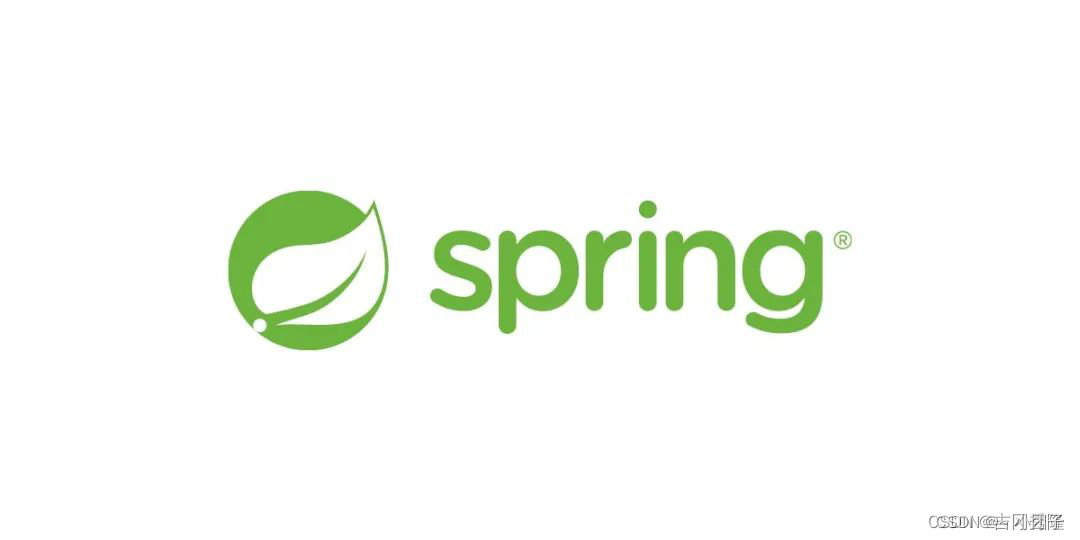
💗AOP-官方文档
🍝AOP 讲解
AOP 讲解: spring-framework-5.3.8\docs\reference\html/index.html
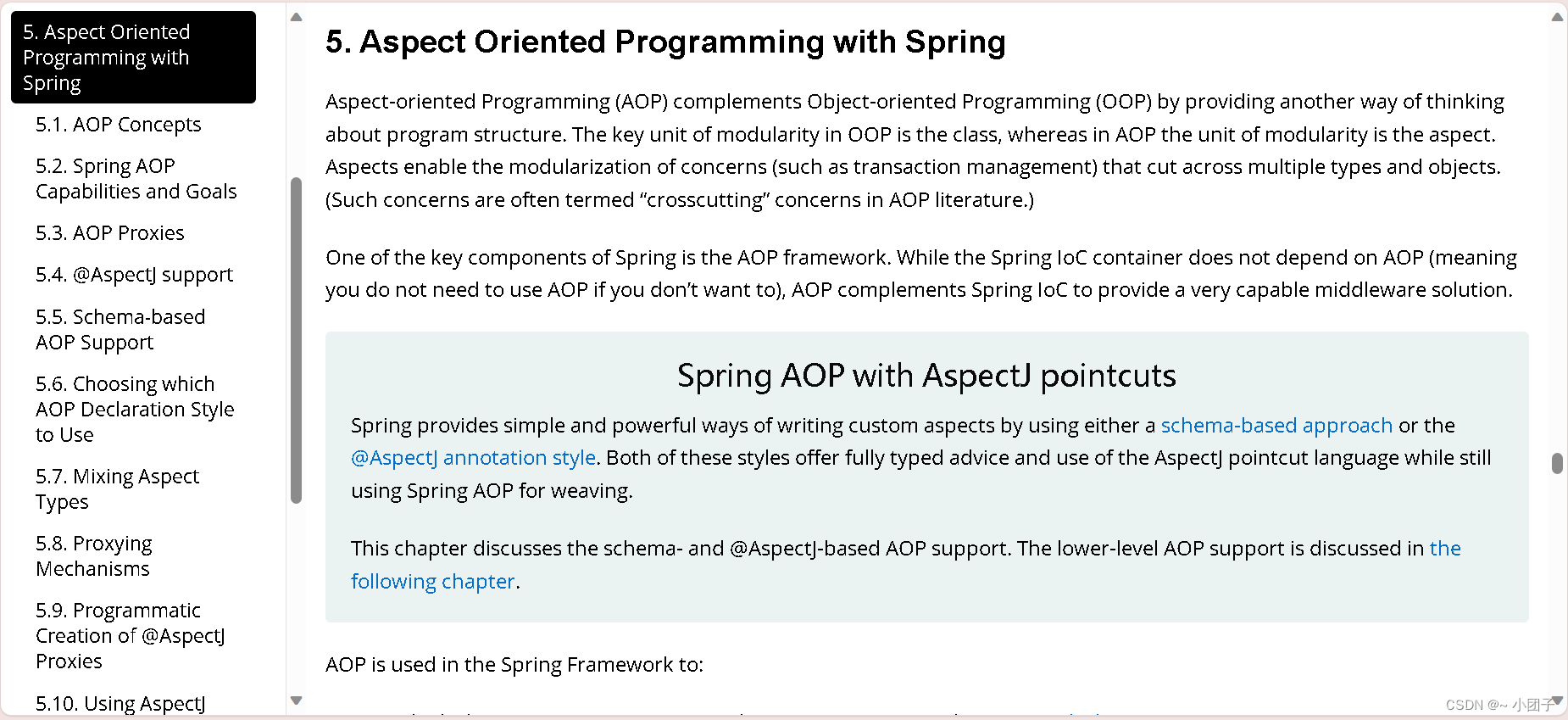
🍝AOP APIs
AOP APIs: spring-framework-5.3.8\docs\javadoc-api\index.html
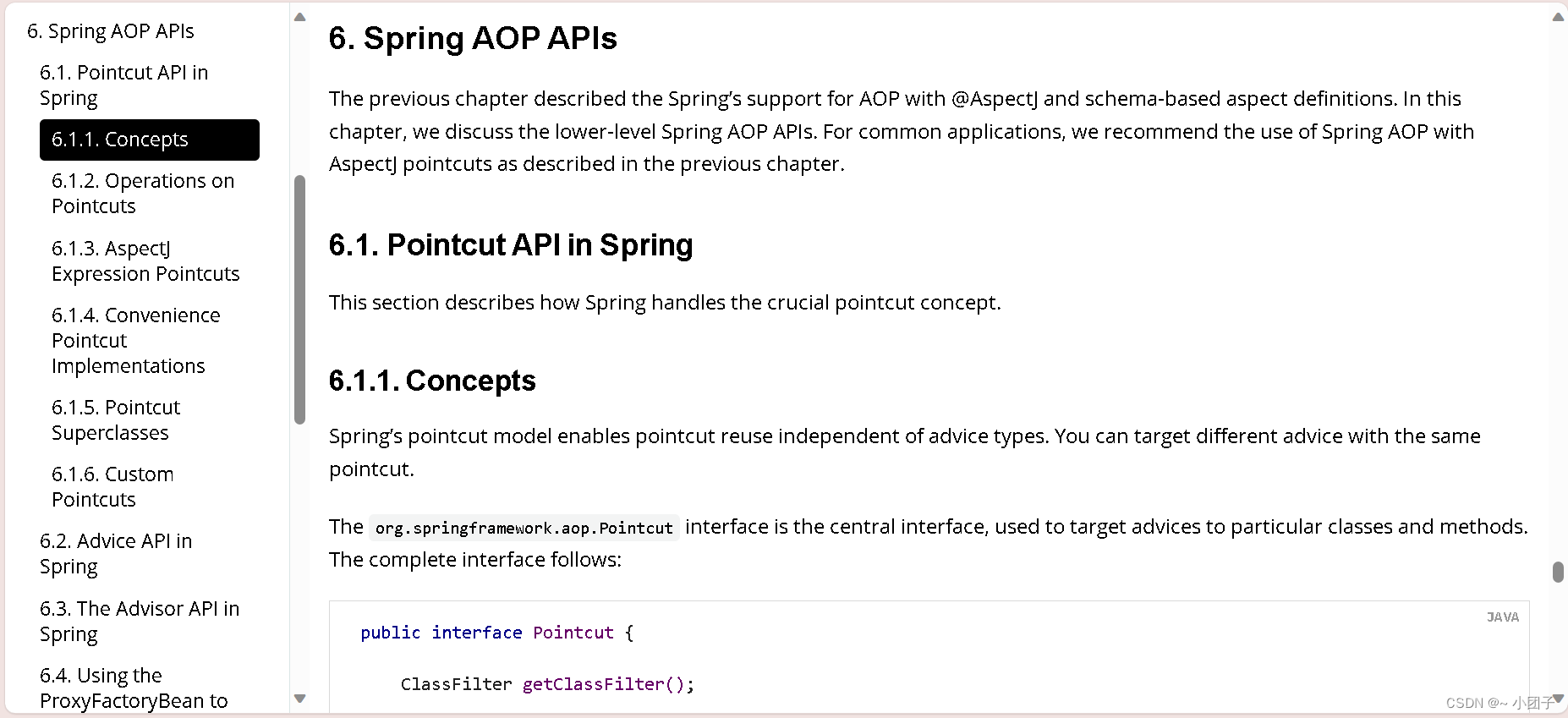
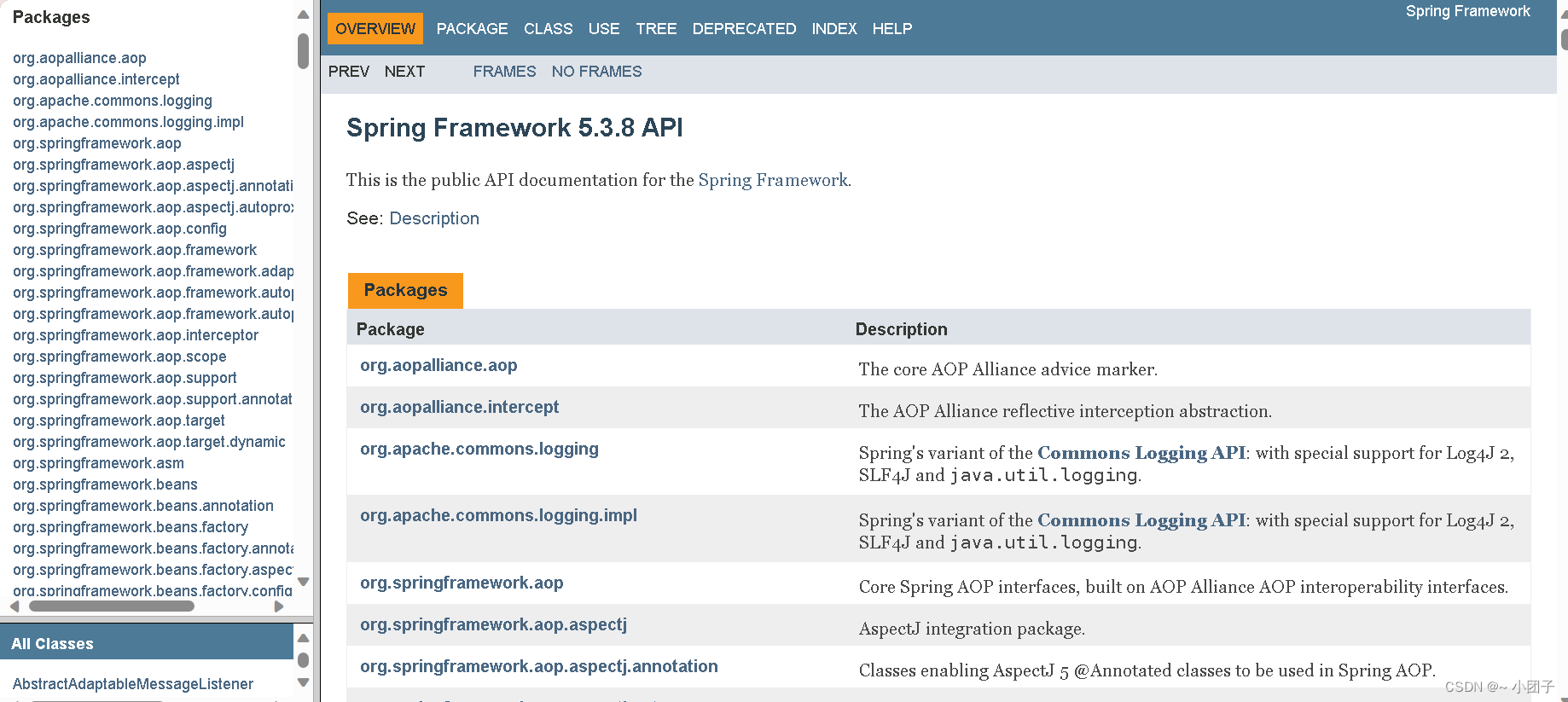
💗动态代理
🍝初始动态代理
需求说明
1.由Vehicle (交通工具接口, 有一个run方法), 下面有两个类 Car 和 Ship
2.当运行Car对象的 run 方法 和 ship对象的 run 方法时, 输入如下内容
交通工具开始运行了…
轮船在海上航行…
交通工具停止运行了…
交通工具开始运行了…
小汽车在路上跑…
交通工具停止运行了…
解决方案一: 传统方案
//接口, 该接口有run方法
public interface Vehicle {void run();
}
public class Car implements Vehicle{@Overridepublic void run() {System.out.println("交通工具开始运行了....");System.out.println("小汽车在路上 running....");System.out.println("交通工具停止运行了....");}
}
public class Ship implements Vehicle{@Overridepublic void run() {System.out.println("交通工具开始运行了....");System.out.println("大轮船在路上 running....");System.out.println("交通工具停止运行了....");}
}
public class TestVehicle {@Testpublic void run() {//OOP基础=>java基础Vehicle vehicle = new Ship();//动态绑定vehicle.run();}
}
来思考一下, 这个解决方案好吗? ====> 代码冗余, 其实就是单个对象的调用, 并没有很好的解决.
解决方案二: 动态代理方式
动态代理解决思路: 在调用方法时, 使用反射机制, 根据方法去决定调用哪个对象方法
public class VehicleProxyProvider {//定义一个属性//target_vehicle 表示真正要执行的对象//该对象实现了Vehicle接口private Vehicle target_vehicle;//构造器public VehicleProxyProvider(Vehicle target_vehicle) {this.target_vehicle = target_vehicle;}//编写一个方法, 可以返回一个代理对象//解读://1.这个方法非常重要, 理解有一定难度//2.public Vehicle getProxy() {//得到类加载器ClassLoader classLoader =target_vehicle.getClass().getClassLoader();//得到要代理的对象/被执行对象 的接口信息, 底层是通过接口来完成调用Class<?>[] interfaces = target_vehicle.getClass().getInterfaces();//创建InvocationHandler 对象//因为 InvocationHandler 是接口, 所以我们可以通过匿名对象的方式来创建该对象/*** public interface InvocationHandler {* public Object invoke(Object proxy, Method method, Object[] args)* throws Throwable;* }* invoke 方法是将来执行target_vehicle的方法时, 会调用到*/InvocationHandler invocationHandler = new InvocationHandler() {/*class VehicleProxyProvider$01 implements InvocationHandler {@Overridepublic Object invoke(Object proxy, Method method, Object[] args) throws Throwable {System.out.println("交通工具开始运行了....");//这里是我们的反射基础 => OOPObject result = method.invoke(target_vehicle, args);System.out.println("交通工具停止运行了....");return result;}}InvocationHandler invocationHandler = new VehicleProxyProvider$01();*//*** invoke 方法是将来执行我们的target_vehicle的方法时, 会调用到** @param proxy 表示代理对象* @param method 就是通过代理对象调用方法时, 的那个方法 代理对象.run()* @param args 表示调用 代理对象.run(xx) 传入的参数* @return 表示 代理对象.run(xx) 执行后的结果.* @throws Throwable*/@Overridepublic Object invoke(Object proxy, Method method, Object[] args) throws Throwable {System.out.println("交通工具开始运行了....");//这里是我们的反射基础 => OOP//method 是 public abstract void com.zzw.spring.aop.proxy.Vehicle.run()//target_vehicle 是 Ship对象//args 是 null//这里通过反射+动态绑定机制, 就会执行到被代理对象的方法//执行完毕就返回Object result = method.invoke(target_vehicle, args);System.out.println("交通工具停止运行了....");return result;}};/*public static Object newProxyInstance(ClassLoader loader,Class<?>[] interfaces,InvocationHandler h)解读1.Proxy.newProxyInstance() 可以返回一个代理对象2.ClassLoader loader: 类加载器,3.Class<?>[] interfaces 就是将来要代理的对象的接口信息4.InvocationHandler h 调用处理器/对象, 有一个非常重要的方法invoke*/Vehicle proxy =(Vehicle) Proxy.newProxyInstance(classLoader, interfaces, invocationHandler);return proxy;}
}
public class TestVehicle {@Testpublic void proxyRun() {//创建Ship对象Vehicle vehicle = new Ship();//创建VehicleProxyProvider对象, 并且我们传入的要代理的对象VehicleProxyProvider vehicleProxyProvider= new VehicleProxyProvider(new Car());//获取代理对象, 该对象可以代理执行方法//解读//1.proxy 编译类型Vehicle,//2.运行类型 是代理类型, 即 class com.sun.proxy.$Proxy8Vehicle proxy = vehicleProxyProvider.getProxy();System.out.println("proxy的编译类型是 Vehicle");System.out.println("proxy的运行类型是" + proxy.getClass());//下面解读/debug怎么执行到 代理对象的 public Object invoke(Object proxy, Method method, Object[] args)//梳理完毕, proxy的编译类型是Vehicle, 运行类型是Proxy class com.sun.proxy.$Proxy8//所以当执行run方法时, 会执行到 代理对象的invoke//如果体现动态 [1.被代理的对象 2.方法]//proxy.run();String result = proxy.fly(10000);System.out.println("result=" + result);System.out.println("ok");}
debug

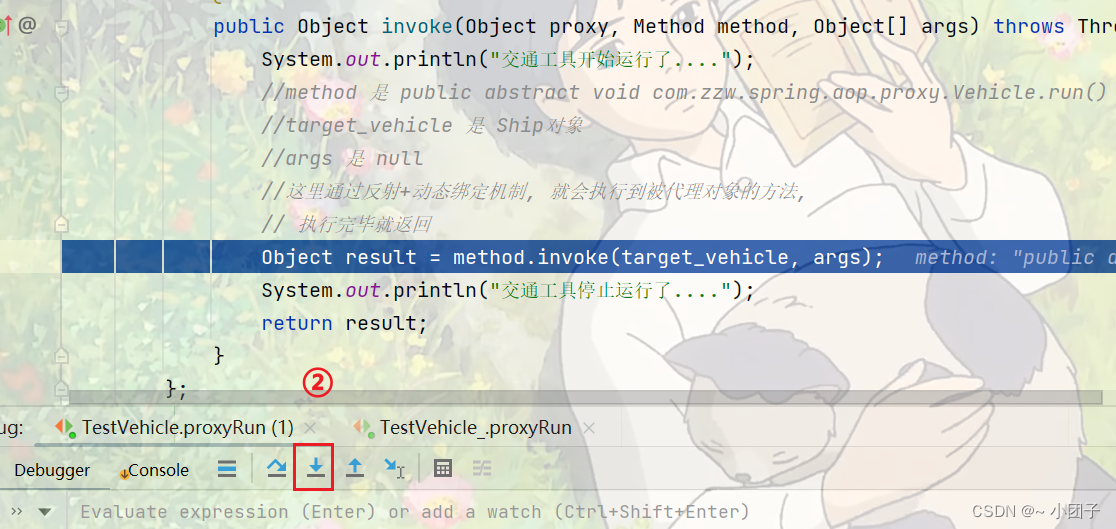
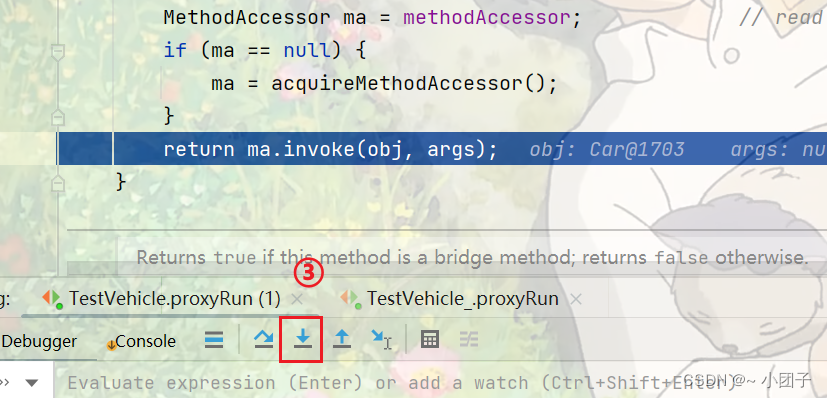

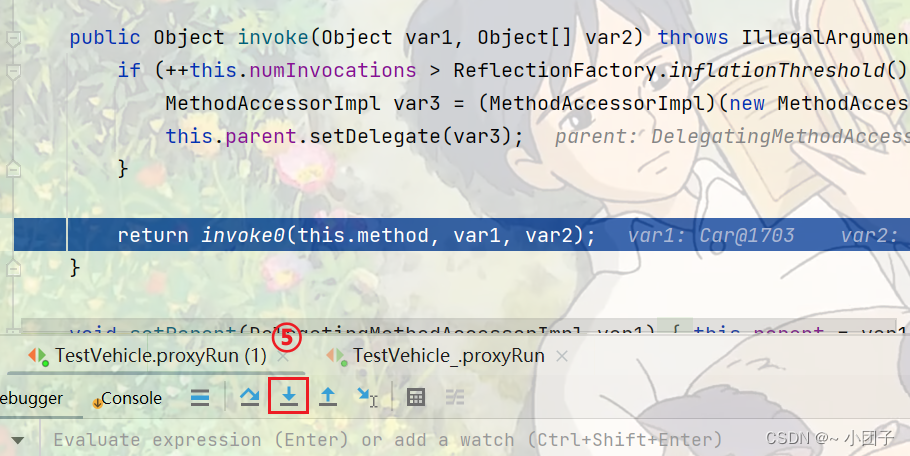
🍝动态代理深入
需求说明
1.有一个SmartAnimal 接口, 可以完成简单的加减法, 要求在执行 getSum() 和 getSub() 时, 输出执行前, 执行过程, 执行后的日志结果. 输出内容如下:
日志-方法名-getSum-参数 1.5 4.5
方法内部打印result = 6.0
日志-方法名-getSum-结果result= 6.0
=================================
日志-方法名-getSub-参数 1.4 3.3
方法内部打印result = -1.9
日志-方法名-getSub-结果result= -1.9
解决方案一: 传统方案
public interface SmartAnimalAble {//求和float getSum(float i, float j);//求差float getSub(float i, float j);
}
public class SmartCat implements SmartAnimalAble {@Overridepublic float getSum(float i, float j) {System.out.println("日志-方法名-getSum-参数 " + i + " " + j);float result = i + j;System.out.println("方法内部打印result = " + result);System.out.println("日志-方法名-getSum-结果result= " + (i + j));return result;}@Overridepublic float getSub(float i, float j) {System.out.println("日志-方法名-getSub-参数 " + i + " " + j);float result = i - j;System.out.println("方法内部打印result = " + result);System.out.println("日志-方法名-getSub-结果result= " + (i - j));return result;}
}
public class AopTest {@Testpublic void run() {SmartAnimalAble smartAnimalAble = new SmartCat();smartAnimalAble.getSum(1.5f, 4.5f);System.out.println("=================================");smartAnimalAble.getSub(1.4f, 3.3f);}
}
解决方案二: 动态代理方式
考虑代理对象调用方法(底层是反射调用)时, 可能出现的异常- [横切关注点]
//可以返回一个动态代理对象, 可以执行SmartCat对象的方法
public class MyProxyProvider {//这是一个属性, 是我们要执行的目标对象//该对象实现了SmartAnimal接口private SmartAnimalAble target_obj;//构造器MyProxyProvider(SmartAnimalAble target_obj) {this.target_obj = target_obj;}//编写一个方法, 可以返回一个代理对象//该代理对象可以执行目标对象public SmartAnimalAble getProxy() {//1.得到类加载器ClassLoader classLoader =target_obj.getClass().getClassLoader();//2.得到要执行的目标对象的接口信息Class<?>[] interfaces = target_obj.getClass().getInterfaces();//3.创建InvocationHandler 对象InvocationHandler invocationHandler = new InvocationHandler() {@Overridepublic Object invoke(Object proxy, Method method, Object[] args) throws Throwable {String name = method.getName();//方法名Object result = null;try {System.out.println("方法执行前-日志-方法名-" + name + "-参数 "+ Arrays.asList(args));//这里从aop的角度看,就是一个横切关注点-前置通知//使用反射调用方法result = method.invoke(target_obj, args);System.out.println("方法执行正常结束-日志-方法名-" + name + "-结果result= "+ result);//这里从aop的角度看, 也是一个横切关注点-返回通知return result;} catch (Exception e) {e.printStackTrace();//如果反射执行方法时, 出现异常, 就会进入到catch{}System.out.println("方法执行异常-日志-方法名-" + name + "-异常类型="+ e.getClass().getName());//这里从aop的角度看, 又是一个横切关注点-异常通知} finally {//不管你是否出现了异常, 最终都会执行到 finally {}//这里从aop的角度看, 还是一个横切关注点-最终通知System.out.println("方法最终结束-日志-方法名-" + name);}return result;}};//创建代理对象SmartAnimalAble proxy =(SmartAnimalAble) Proxy.newProxyInstance(classLoader, interfaces, invocationHandler);return proxy;}
}
public class AopTest {@Testpublic void smartCatTestProxy() {//创建SmartCat对象SmartAnimalAble smartAnimalAble = new SmartCat();MyProxyProvider myProxyProvider= new MyProxyProvider(smartAnimalAble);//获取代理对象, 该对象可以代理执行方法SmartAnimalAble proxy = myProxyProvider.getProxy();System.out.println("proxy的编译类型是 SmartAnimalAble");System.out.println("proxy的运行类型是 " + proxy.getClass());//proxy的编译类型是SmartAnimal, 运行类型是 Class com.sun.proxy.$Proxy8//所以当执行getSum方法时, 会执行到 代理对象的invokeproxy.getSum(1.2f, 2.4f);System.out.println("=================================");proxy.getSub(1.3f, 4.5f);System.out.println("ok");}
}
🍝AOP问题提出
在MyProxyProvider.java中, 我们的输出语句功能比较弱, 在实际开发中, 我们希望是以一个方法的形式, 嵌入到真正执行的目标方法前.
如图分析

📗使用土方法解决
1). 需求分析
使用土方法解决前面的问题, 后面使用Spring的AOP组件完成
2). 先建一个包, 把相关文件拷贝过来, 进行修改完成.
//我们的一个方法, 在目标对象执行前执行
public void before(Method method, Object[] args) {System.out.println("before方法执行前-日志-方法名-" + method.getName() + "-参数 "+ Arrays.asList(args));//这里从aop的角度看,就是一个横切关注点-前置通知
}//我们的一个方法, 在目标对象执行后执行
public void after(Method method, Object result) {System.out.println("after方法执行正常结束-日志-方法名-" + method.getName() + "-结果result= "+ result);//这里从aop的角度看, 也是一个横切关注点-返回通知
}
@Override
public Object invoke(Object proxy, Method method, Object[] args) throws Throwable {String name = method.getName();//方法名Object result = null;before(method, args);//使用反射调用方法result = method.invoke(target_obj, args);after(method, result);return result;
}
3). 该方法问题分析: 耦合度高
📗 对土方法解耦-开发最简单的AOP类
public class ZzwAOP {//我们的一个方法, 在目标对象执行前执行public static void before(Method method, Object[] args) {System.out.println("ZzwHsp-方法执行前-日志-方法名-" + method.getName() + "-参数 "+ Arrays.asList(args));//这里从aop的角度看,就是一个横切关注点-前置通知}//我们的一个方法, 在目标对象执行后执行public static void after(Method method, Object result) {System.out.println("ZzwHsp-方法执行正常结束-日志-方法名-" + method.getName() + "-结果result= "+ result);//这里从aop的角度看, 也是一个横切关注点-返回通知}
}
@Override
public Object invoke(Object proxy, Method method, Object[] args) throws Throwable {String name = method.getName();//方法名Object result = null;try {//before(method, args);ZzwAOP.before(method, args);//使用反射调用方法result = method.invoke(target_obj, args);//after(method, result);ZzwAOP.after(method, result);return result;} catch (Exception e) {}
}
📗 土方法缺点
土方法 不够灵活;
土方法 复用性差;
土方法 是一种硬编码 (因为没有注解和反射支撑)
Spring AOP 闪亮登场 - 底层是ASPECTJ
💗Spring AOP
🍝基本介绍
- 什么是AOP
AOP的全称(aspect oriented programming), 面向切面编程.
第一张图

- AOP实现方式
1.基于动态代理的方式 [内置aop实现]
2.使用框架aspectj来实现
🍝AOP编程 快速入门
●说明
1.需要引入核心的aspect包
2.在切面类中声明通知方法
1)前置通知: @Before
2)返回通知: @AfterReturning
3)异常通知: @AfterThrowing
4)后置通知: @After 最终通知
5)环绕通知: @Around
●需求说明
我们使用aop编程的方式, 来实现手写的动态代理案例效果, 以上一个案例为例进行讲解.
1.导入AOP编程需要的包

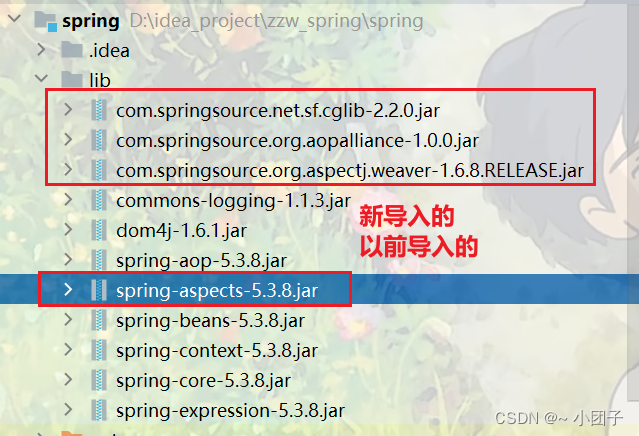
2.创建包spring/aop/aspect
package com.zzw.spring.aop.aspectj;public interface SmartAnimalAble {//求和float getSum(float i, float j);//求差float getSub(float i, float j);
}
易错点: 不要引入别的包下的SmartAnimalAble, 要引入同包下的SmartAnimalAble
@Component //使用@Component 当spring容器启动时, 将 SmartDog 注入到容器
public class SmartDog implements SmartAnimalAble {@Overridepublic float getSum(float i, float j) {float result = i + j;System.out.println("方法内部打印result = " + result);return result;}@Overridepublic float getSub(float i, float j) {float result = i - j;System.out.println("方法内部打印result = " + result);return result;}
}
切面类, 类似于我们前面自己写的MyProxyProvider, 但是功能强大很多
@Aspect //表示是一个切面类[底层切面编程的支撑(动态代理+反射+动态绑定)]
@Component //会将SmartAnimalAspect注入到容器
public class SmartAnimalAspect {//希望将showBeginLog方法切入到SmartDog-getSum前执行-前置通知/*** 解读* 1. @Before 表示是前置通知, 即在我们的目标对象执行方法前执行* 2. value = "execution(public float com.zzw.spring.aop.aspectj.SmartDog.getSum(float, float))"* 指定切入到哪个类的哪个方法 形式是: 访问修饰符 返回类型 全类名.方法名(形参列表)* 3. showBeginLog方法可以理解成就是一个切入方法, 这个方法名是可以由程序员指定的 比如:showBeginLog* 4. JoinPoint joinPoint 在底层执行时, 由AspectJ切面编程框架, 会给该切入方法传入 joinPoint对象* , 通过该方法, 程序员可以获取到 相关信息* @param joinPoint*/@Before(value = "execution(public float com.zzw.spring.aop.aspectj.SmartDog.getSum(float, float))")public void showBeginLog(JoinPoint joinPoint) {//通过连接点对象joinPoint, 可以获取方法签名Signature signature = joinPoint.getSignature();System.out.println("切面类showBeginLog()-方法执行前-日志-方法名-" + signature.getName() + "-参数 "+ Arrays.asList(joinPoint.getArgs()));}//返回通知: 即把showSuccessEndLog方法切入到目标对象方法正常执行完毕后的地方@AfterReturning(value = "execution(public float com.zzw.spring.aop.aspectj.SmartDog.getSum(float, float))")public void showSuccessEndLog(JoinPoint joinPoint, Object res) {Signature signature = joinPoint.getSignature();System.out.println("切面类showSuccessEndLog()-方法执行正常结束-日志-方法名-" + signature.getName());}//异常通知: 即把showExceptionLog方法切入到目标对象方法执行发生异常后的catch{}@AfterThrowing(value = "execution(public float com.zzw.spring.aop.aspectj.SmartDog.getSum(float, float))")public void showExceptionLog(JoinPoint joinPoint) {Signature signature = joinPoint.getSignature();System.out.println("切面类showExceptionLog()-方法执行异常-日志-方法名-" + signature.getName());}//最终通知: 即把showFinallyEndLog方法切入到目标方法执行后, 不管是否发生异常都要执行, finally{}@After(value = "execution(public float com.zzw.spring.aop.aspectj.SmartDog.getSum(float, float))")public void showFinallyEndLog(JoinPoint joinPoint) {Signature signature = joinPoint.getSignature();System.out.println("切面类showFinallyEndLog()-方法最终执行完毕-日志-方法名-" + signature.getName());}
}
新建beans08.xml
<?xml version="1.0" encoding="UTF-8"?>
<beans xmlns="http://www.springframework.org/schema/beans"xmlns:xsi="http://www.w3.org/2001/XMLSchema-instance"xmlns:context="http://www.springframework.org/schema/context"xsi:schemaLocation="http://www.springframework.org/schema/beans http://www.springframework.org/schema/beans/spring-beans.xsd http://www.springframework.org/schema/context https://www.springframework.org/schema/context/spring-context.xsd"><context:component-scan base-package="com.zzw.spring.aop.aspectj"/><!--开启基于注解的AOP功能--><aop:aspectj-autoproxy/>
</beans>
测试
public class AopAspectjTest {@Testpublic void smartDogTestByProxy() {ApplicationContext ioc =new ClassPathXmlApplicationContext("beans08.xml");//这里我们需要通过接口类型来获取到注入的SmartDog对象-就是代理对象SmartAnimalAble smartAnimalAble =ioc.getBean(SmartAnimalAble.class);smartAnimalAble.getSum(1, 2);//System.out.println("smartAnimalAble运行类型是 " + smartAnimalAble.getClass());//class com.sun.proxy.$Proxy16}
}
🍝注意事项和细节
1.关于切面类方法命名可以自己规范一下, 比如showBeginLog(), showSuccessEndLog(), showExceptionLog(), showFinallyEndLog()
2.切入表达式的更多配置, 比如使用模糊配置
@Before(value=“execution(* com.zzw.aop.proxy.SmartDog.*(…))”)
第一个\*表示: 任意修饰符和返回类型
第二个\*表示: 任意方法名
..表示: 任意形参列表
3.表示所有访问权限, 所有包下的所有类的所有方法, 都会被执行该前置通知方法
@Before(value=“execution(* *.*(…))”)
4.当spring容器开启了 基于注解的AOP功能 <aop:aspectj-autoproxy/>, 我们获取注入的对象, 需要以接口的类型来获取, 因为你注入的对象.getClass() 已经是代理类型了
5.当spring容器开启了 基于注解的AOP功能 <aop:aspectj-autoproxy/>, 我们获取注入的对象, 也可以通过id来获取, 但是也要转成接口类型.
//这里我们需要通过接口类型来获取到注入的SmartDog对象-就是代理对象
SmartAnimalAble smartAnimalAble = ioc.getBean(SmartAnimalAble.class);//SmartAnimalAble smartAnimalAble = (SmartAnimalAble) ioc.getBean("smartDog");
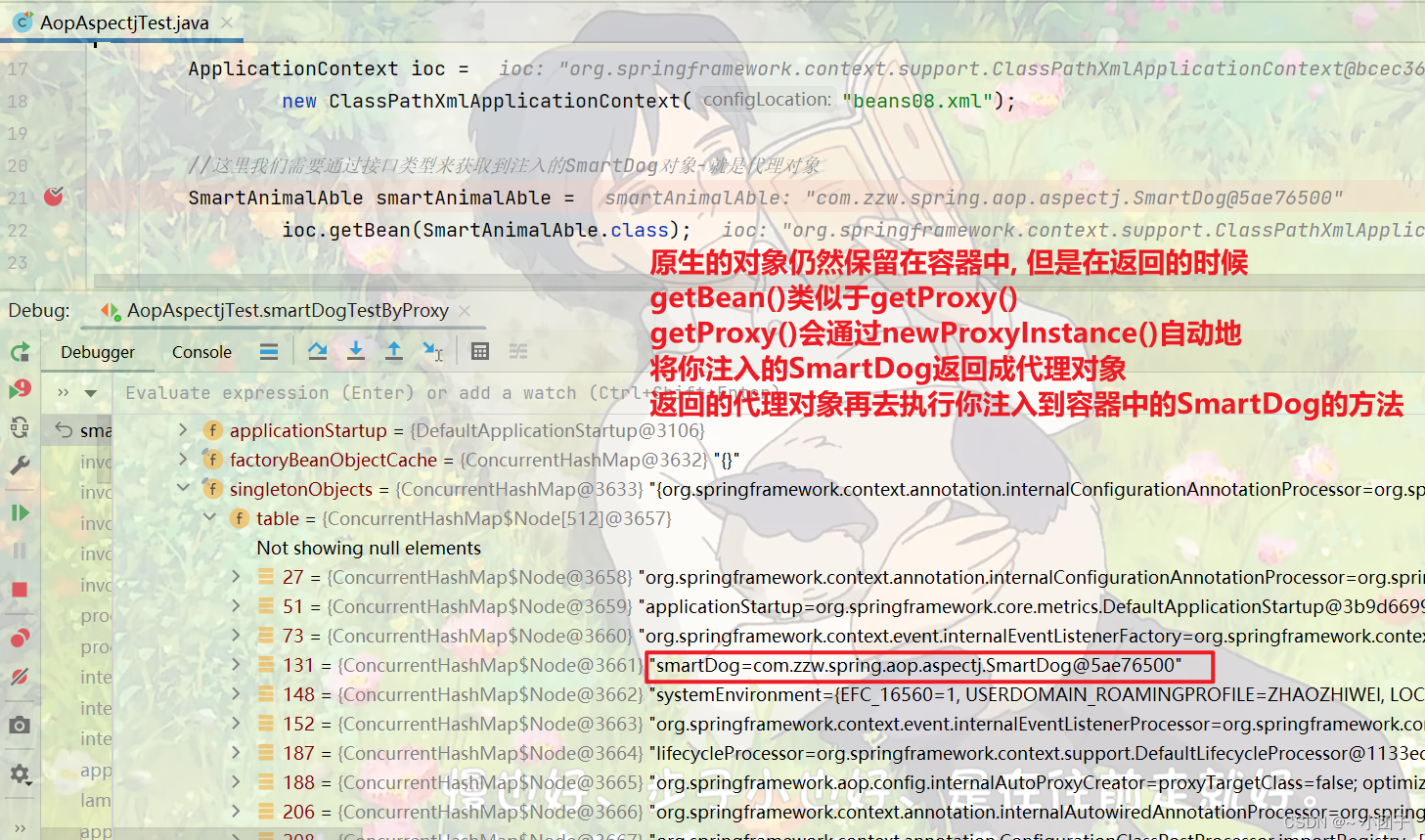
🍝课后作业
1.有接口 UsbInterface (方法 work)
2.实现子类 Phone 和 Camera 实现 UsbInterface
3.请在SmartAnimalAspect 切面类, 写一个方法(可输出日志信息作为前置通知, 在Phone和Camera对象执行work方法前调用
4.其它如返回通知, 异常通知, 后置通知, 也可以加入.
新建包 com.zzw.spring.aop.homework;
接口
public interface UsbInterface {void work(String name);
}
实现类
@Component //将Phone当作一个组件注入到容器中
public class Phone implements UsbInterface{@Overridepublic void work(String name) {System.out.println(name + " 手机正在工作中....");}
}
@Component //将Camera对象注入到Spring容器
public class Camera implements UsbInterface{@Overridepublic void work(String name) {System.out.println(name + " 相机正在工作中....");}
}
切面类
@Aspect
@Component
public class SmartAnimalAspect {//希望将showBeginLog切入到Phone/Camera-work() 前执行//前置通知//切入表达式也可以指向接口的方法, 这时切入表达式会对实现了接口的类/对象生效//比如下面我们是对UsbInterface切入, 那么对实现类 Phone/Camera 都生效//@Before(value = "execution(public void *.work(String))")@Before(value = "execution(public void com.zzw.spring.aop.homework.UsbInterface.work(String))")public void showBeginLog(JoinPoint joinPoint) {//通过连接点对象, 可以获取方法签名Signature signature = joinPoint.getSignature();System.out.println("切面类showBeginLog()-方法执行前-日志-方法名-" + signature.getName() + "-参数"+ Arrays.asList(joinPoint.getArgs()));}//返回通知@AfterReturning(value = "execution(public void UsbInterface.work(String))")//@AfterReturning(value = "execution(public void com.zzw.spring.aop.homework.*.work(String))")public void showSuccessEndLog(JoinPoint joinPoint) {//通过连接点对象, 可以获取方法名Signature signature = joinPoint.getSignature();System.out.println("切面类showSuccessEndLog()-方法执行正常结束-日志-方法名-" + signature.getName());}//异常通知//@AfterThrowing(value = "execution(public void *.work(String))")@AfterThrowing(value = "execution(public void UsbInterface.work(String))")public void showExceptionLog(JoinPoint joinPoint) {//通过连接点对象, 可以获取方法名Signature signature = joinPoint.getSignature();System.out.println("切面类showExceptionLog()-方法执行异常-日志-方法名-" + signature.getName());}//后置通知//@After(value = "execution(public void *.work(String))")@After(value = "execution(public void UsbInterface.work(String))")public void showFinallyEndLog(JoinPoint joinPoint) {//通过连接点对象, 可以获取方法名Signature signature = joinPoint.getSignature();System.out.println("切面类showFinallyEndLog()-方法最终执行完毕-日志-方法名-" + signature.getName());}
}
beans09.xml
<?xml version="1.0" encoding="UTF-8"?>
<beans xmlns="http://www.springframework.org/schema/beans"xmlns:xsi="http://www.w3.org/2001/XMLSchema-instance"xmlns:context="http://www.springframework.org/schema/context"xmlns:aop="http://www.springframework.org/schema/aop"xsi:schemaLocation="http://www.springframework.org/schema/beans http://www.springframework.org/schema/beans/spring-beans.xsd http://www.springframework.org/schema/context https://www.springframework.org/schema/context/spring-context.xsd http://www.springframework.org/schema/aop https://www.springframework.org/schema/aop/spring-aop.xsd"><context:component-scan base-package="com.zzw.spring.aop.homework"/><!--开启基于注解的AOP功能--><aop:aspectj-autoproxy/>
</beans>
测试类
public class AspAspectjTest {public static void main(String[] args) {ApplicationContext ioc =new ClassPathXmlApplicationContext("beans09.xml");UsbInterface phone = (UsbInterface) ioc.getBean("phone");phone.work("华为");System.out.println("===================================");UsbInterface camera = (UsbInterface) ioc.getBean("camera");camera.work("索尼");//System.out.println("phone的运行类型是" + phone.getClass());}
}
🐋AOP-切入表达式
切入点表达式
1.作用
通过表达式的方式定位一个或多个具体的连接点
2.语法细节
①切入点表达式的语法格式
execution([权限修饰符] [返回值类型] [简单类名/全类名] [方法名] (参数列表))
②举例说明
| 表达式 | execution(* com.zzw.spring.aop.aspectj.SmartDog.*(..)) |
|---|---|
| 含义 | 如果SmartAnimalAble是接口, 则表示 接口/类 中声明的所有方法. 第一个 * 代表任意修饰符及任意返回值 第二个 * 表示任意方法 .. 匹配任意数量, 任意类型的参数 (规定.的数量是2个) 若目标类, 接口与该切面类在同一个包中可以省略包名 |
| 表达式 | execution(public * SmartDog.*(..)) |
|---|---|
| 含义 | SmartDog 接口/类 中的所有公有方法 |
| 表达式 | execution(public double SmartDog.*(..)) |
|---|---|
| 含义 | SmartDog 接口/类 中返回double类型数值的方法 |
| 表达式 | execution(public double SmartDog.*(double, ..)) |
|---|---|
| 含义 | 第一个参数为double类型的方法. ..匹配任意数量, 任意类型的参数 |
| 表达式 | execution(public double SmartDog.*(double, double)) |
|---|---|
| 含义 | 参数类型为double, double类型的方法 |
| 表达式 | execution(public double SmartDog.*(double, double)) |
|---|---|
| 含义 | 参数类型为double, double类型的方法 |
③在AspectJ中, 切入点表达式可以通过&&, ||, ! 等操作符结合起来
| 表达式 | execution(* *.add(int, ..)) || execution(* *.sub(int, ..)) |
|---|---|
| 含义 | 任意类中第一个参数为int类型的add方法或sub方法 |
💧注意事项和细节
1.切入表达式也可以指向类的方法, 这时切入表达式会对该类/对象生效
2.切入表达式也可以指向接口的方法, 这时切入表达式会对实现了接口的类/对象生效
3.切入表达式也可以对没有实现接口的类, 进行切入
@Component //把Car视为一个组件[对象], 注入到Spring容器
public class Car {public void run() {System.out.println("小汽车 run...");}
}
//切面类
@Aspect //表示是一个切面类
@Component //会将SmartAnimalAspect注入到容器
public class SmartAnimalAspect {//给Car配置一个前置通知@Before(value = "execution(public void Car.run())")public void ok1(JoinPoint joinPoint) {Signature signature = joinPoint.getSignature();System.out.println("切面类的ok1()-执行的目标方法-" + signature.getName());}
}
测试
public class AopAspectjTest {@Testpublic void test3() {ApplicationContext ioc =new ClassPathXmlApplicationContext("beans08.xml");Car car = ioc.getBean(Car.class);//说明: car对象仍然是代理对象System.out.println("car的运行类型=" + car.getClass());//car的运行类型=class com.zzw.spring.aop.aspectj.Car$$EnhancerBySpringCGLIB$$5e9a8b7acar.run();}
}
4.补充: 动态代理jdk的Proxy和Spring的CGlib
🐋AOP-JoinPoint
1.通过JoinPoint可以获取到调用方法的签名
2.其他常用方法
@Aspect //表示是一个切面类
@Component //会将SmartAnimalAspect注入到容器
public class SmartAnimalAspect {//给Car配置一个最终通知@After(value = "execution(public void Car.run())")public void ok4(JoinPoint joinPoint) {//演示joinPoint常用的方法joinPoint.getSignature().getName();//获取目标方法名joinPoint.getSignature().getDeclaringType().getSimpleName();//获取目标方法所属类的简单类名joinPoint.getSignature().getDeclaringTypeName();//获取目标方法所属类的类名joinPoint.getSignature().getModifiers();//获取目标方法声明类型(public, private, protected)Object[] args = joinPoint.getArgs();//获取传入目标方法的参数, 返回一个数组joinPoint.getTarget();//获取被代理的对象joinPoint.getThis();//获取代理对象自己 }
}
🐋返回通知获取结果
切面类
@Aspect //表示是一个切面类[底层切面编程的支撑(动态代理+反射+动态绑定)]
@Component //会将SmartAnimalAspect注入到容器
public class SmartAnimalAspect {//返回通知: 即把showSuccessEndLog方法切入到目标对象方法正常执行完毕后的地方//解读//1.如果我们希望把目标方法, 执行的结果, 返回给切入方法//2.可以在 @AfterReturning 增加属性, 比如 returning = "res"//3.同时在切入方法增加 Object res//4.注意: returning = "res" 和 Object res 的 res名字一样@AfterReturning(value = "execution(public float com.zzw.spring.aop.aspectj.SmartDog.getSum(float, float))", returning = "res")public void showSuccessEndLog(JoinPoint joinPoint, Object res) {Signature signature = joinPoint.getSignature();System.out.println("切面类showSuccessEndLog()-方法执行正常结束-日志-方法名-" + signature.getName() + " 返回的结果是=" + res);}
}
🐋异常通知获取异常信息
如何在异常通知方法中获取异常信息
@Component //使用@Component 当spring容器启动时, 将 SmartDog 注入到容器
public class SmartDog implements SmartAnimalAble {@Overridepublic float getSum(float i, float j) {float result = i + j;int res = 1 / 0;//模拟一个算数异常System.out.println("方法内部打印result = " + result);return result;}
}
切面类
@Aspect //表示是一个切面类[底层切面编程的支撑(动态代理+反射+动态绑定)]
@Component //会将SmartAnimalAspect注入到容器
public class SmartAnimalAspect {//异常通知: 即把showExceptionLog方法切入到目标对象方法执行发生异常后的catch{}@AfterThrowing(value = "execution(public float com.zzw.spring.aop.aspectj.SmartDog.getSum(float, float))", throwing = "throwable")public void showExceptionLog(JoinPoint joinPoint, Throwable throwable) {Signature signature = joinPoint.getSignature();System.out.println("切面类showExceptionLog()-方法执行异常-日志-方法名-" + signature.getName() + " 异常信息=" + throwable);}
}
🐋环绕通知
需求: 如果使用环绕通知完成其它四个通知的功能.
新建SmartAnimalAspect2切面类, 并把SmartAnimalAspect切面类注解注释, 避免干扰; 去掉SmartDog的异常代码.
//切面类
@Aspect //表示是一个切面类[底层切面编程的支撑(动态代理+反射+动态绑定)]
@Component //会将SmartAnimalAspect注入到容器
public class SmartAnimalAspect2 {//演示环绕通知的使用//1. @Around 表示这是一个环绕通知[可以完成其它四个通知的功能]//2. (value = "execution(public float getSum(float, float))") 切入点表达式//3. doAround 表示要切入的方法 - 调用的基本结构 try-catch-finally@Around(value = "execution(public float com.zzw.spring.aop.aspectj.SmartDog.getSum(float, float))")public Object doAround(ProceedingJoinPoint joinPoint) {Object result = null;String methodName = joinPoint.getSignature().getName();try {//1.相当于前置通知完成的事情Object[] args = joinPoint.getArgs();List<Object> argList = Arrays.asList(args);System.out.println("AOP环绕通知[=前置通知]--" + methodName + "方法开始了--参数有: " + argList);//在环绕通知中一定要调用joinPoint.proceed()来执行目标方法result = joinPoint.proceed();//2.相当于返回通知完成的事情System.out.println("AOP环绕通知[=返回通知]--" + methodName + "方法结束了--结果是: " + result);} catch (Throwable throwable) {//3.相当于异常通知完成的事情System.out.println("AOP环绕通知[=异常通知]--" + methodName + "方法抛出异常--异常对象: " + throwable);} finally {//相当于最终通知完成的事情System.out.println("AOP环绕通知[=最终通知]--" + methodName + "方法最终结束了...");}return result;}
}
测试
public class AopAspectjTest {@Testpublic void testDoAround() {//获取Spring容器ApplicationContext ioc =new ClassPathXmlApplicationContext("beans08.xml");SmartAnimalAble smartAnimalAble = ioc.getBean(SmartAnimalAble.class);smartAnimalAble.getSum(10, 2);}
}结果
Connected to the target VM, address: '127.0.0.1:60160', transport: 'socket'
AOP环绕通知[=前置通知]--getSum方法开始了--参数有: [10.0, 2.0]
方法内部打印result = 12.0
AOP环绕通知[=返回通知]--getSum方法结束了--结果是: 12.0
AOP环绕通知[=最终通知]--getSum方法最终结束了...
🐋切入点表达式重用
为了统一管理切入点表达式, 我们可以使用切入点表达式重用技术
对SmartAnimalAspect.java稍作修改
//切面类, 类似于我们前面自己写的MyProxyProvider, 但是功能强大很多
@Aspect //表示是一个切面类[底层切面编程的支撑(动态代理+反射+动态绑定)]
@Component //会将SmartAnimalAspect注入到容器
public class SmartAnimalAspect {//定义一个切入点, 在后面使用时可以直接引用, 提高了复用性@Pointcut(value = "execution(public float com.zzw.spring.aop.aspectj.SmartDog.getSum(float, float))")public void myPointCut() {}//@Before(value = "execution(public float com.zzw.spring.aop.aspectj.SmartDog.getSum(float, float))")//这里我们使用定义好的切入点@Before(value = "myPointCut()")public void showBeginLog(JoinPoint joinPoint) {//通过连接点对象joinPoint, 可以获取方法签名Signature signature = joinPoint.getSignature();System.out.println("切面类showBeginLog()[使用的myPointCut()]-方法执行前-日志-方法名-" + signature.getName() + "-参数 "+ Arrays.asList(joinPoint.getArgs()));}//返回通知: 即把showSuccessEndLog方法切入到目标对象方法正常执行完毕后的地方//@AfterReturning(value = "execution(public float com.zzw.spring.aop.aspectj.SmartDog.getSum(float, float))", returning = "res")//使用切入点@AfterReturning(value = "myPointCut()", returning = "res")public void showSuccessEndLog(JoinPoint joinPoint, Object res) {Signature signature = joinPoint.getSignature();System.out.println("切面类showSuccessEndLog()-方法执行正常结束-日志-方法名-" + signature.getName() + " 返回的结果是=" + res);}//异常通知: 即把showExceptionLog方法切入到目标对象方法执行发生异常后的catch{}//@AfterThrowing(value = "execution(public float com.zzw.spring.aop.aspectj.SmartDog.getSum(float, float))", throwing = "throwable")//直接使用切入点表达式@AfterThrowing(value = "myPointCut()", throwing = "throwable")public void showExceptionLog(JoinPoint joinPoint, Throwable throwable) {Signature signature = joinPoint.getSignature();System.out.println("切面类showExceptionLog()-方法执行异常-日志-方法名-" + signature.getName() + " 异常信息=" + throwable);}//最终通知: 即把showFinallyEndLog方法切入到目标方法执行后, 不管是否发生异常都要执行, finally{}//@After(value = "execution(public float com.zzw.spring.aop.aspectj.SmartDog.getSum(float, float))")//直接使用切入点表达式@After(value = "myPointCut()")public void showFinallyEndLog(JoinPoint joinPoint) {Signature signature = joinPoint.getSignature();System.out.println("切面类showFinallyEndLog()-方法最终执行完毕-日志-方法名-" + signature.getName());}
}
🐋切面类执行顺序
如果同一个方法, 有多个切面在同一个切入点切入, 那么执行的优先级如何控制
●基本语法
import org.springframework.core.annotation.Order;
通过@order(value=n) 来控制. n值越小, 优先级越高
●代码
新建SmartAnimalAspect3.java, 将SmartAnimalAspect2.java注销, 保留SmartAnimalAspect.java
1.如果这两个类不加@order注解, 那么执行结果如下
SmartAnimalAspect-切面类showBeginLog()[使用的myPointCut()]-方法执行前-日志-方法名-getSum-参数 [1.0, 2.0]
SmartAnimalAspect3-切面类showBeginLog()-方法执行前-日志-方法名-getSum-参数 [1.0, 2.0]
方法内部打印result = 3.0
SmartAnimalAspect3-切面类showSuccessEndLog()-方法执行正常结束-日志-方法名-getSum 返回的结果是=3.0
SmartAnimalAspect3-切面类showFinallyEndLog()-方法最终执行完毕-日志-方法名-getSum
SmartAnimalAspect-切面类showSuccessEndLog()-方法执行正常结束-日志-方法名-getSum 返回的结果是=3.0
SmartAnimalAspect-切面类showFinallyEndLog()-方法最终执行完毕-日志-方法名-getSum
如果两个类加了@order注解
@Order(value = 2)//表示该切面类执行的顺序, value的值越小, 优先级越高
@Aspect
@Component
public class SmartAnimalAspect {//内容省略
}
@Order(value = 1)//表示该切面类执行的顺序, value的值越小, 优先级越高
@Aspect
@Component
public class SmartAnimalAspect3 {//内容省略
}
那么执行结果如下
SmartAnimalAspect3-切面类showBeginLog()-方法执行前-日志-方法名-getSum-参数 [1.0, 2.0]
SmartAnimalAspect-切面类showBeginLog()[使用的myPointCut()]-方法执行前-日志-方法名-getSum-参数 [1.0, 2.0]
方法内部打印result = 3.0
SmartAnimalAspect-切面类showSuccessEndLog()-方法执行正常结束-日志-方法名-getSum 返回的结果是=3.0
SmartAnimalAspect-切面类showFinallyEndLog()-方法最终执行完毕-日志-方法名-getSum
SmartAnimalAspect3-切面类showSuccessEndLog()-方法执行正常结束-日志-方法名-getSum 返回的结果是=3.0
SmartAnimalAspect3-切面类showFinallyEndLog()-方法最终执行完毕-日志-方法名-getSum
💧注意事项和细节
🐧不能理解成: 优先级高的每个消息通知都先执行. 这个方法调用机制和Filter过滤器链式调用类似
🐧方法调用机制如下图所示
👇👇👇👇👇👇👇👇👇👇👇👇👇👇👇👇👇👇👇👇👇👇👇👇👇👇👇👇👇👇👇👇👇👇👇👇👇👇👇👇👇👇👇👇👇👇

🐋基于XML配置AOP
基本说明
前面我们是通过注解来配置aop的, 在spring中, 我们也可以通过xml的方式来配置AOP.
将SmartAnimalAble.java ,SmartDog.java 拷贝至 spring/aop/xml包下
注意: 不要引错包
切面类
//这是我们开发一个切面类, 但是不用注解, 而是使用xml配置
public class SmartAnimalAspect {public void showBeginLog(JoinPoint joinPoint) {//通过连接点对象joinPoint, 可以获取方法签名Signature signature = joinPoint.getSignature();System.out.println("SmartAnimalAspect[XML配置]-切面类showBeginLog()-方法执行前-日志-方法名-" + signature.getName() + "-参数 "+ Arrays.asList(joinPoint.getArgs()));}public void showSuccessEndLog(JoinPoint joinPoint, Object res) {Signature signature = joinPoint.getSignature();System.out.println("SmartAnimalAspect[XML配置]-切面类showSuccessEndLog()-方法执行正常结束-日志-方法名-" + signature.getName() + " 返回的结果是=" + res);}public void showExceptionLog(JoinPoint joinPoint, Throwable throwable) {Signature signature = joinPoint.getSignature();System.out.println("SmartAnimalAspect[XML配置]-切面类showExceptionLog()-方法执行异常-日志-方法名-" + signature.getName() + " 异常信息=" + throwable);}public void showFinallyEndLog(JoinPoint joinPoint) {Signature signature = joinPoint.getSignature();System.out.println("SmartAnimalAspect[XML配置]-切面类showFinallyEndLog()-方法最终执行完毕-日志-方法名-" + signature.getName());}
}
beans09_2.xml
<?xml version="1.0" encoding="UTF-8"?>
<beans xmlns="http://www.springframework.org/schema/beans"xmlns:xsi="http://www.w3.org/2001/XMLSchema-instance"xmlns:aop="http://www.springframework.org/schema/aop"xsi:schemaLocation="http://www.springframework.org/schema/beans http://www.springframework.org/schema/beans/spring-beans.xsd http://www.springframework.org/schema/context https://www.springframework.org/schema/context/spring-context.xsd http://www.springframework.org/schema/aop https://www.springframework.org/schema/aop/spring-aop.xsd"><!--使用XML配置, 完成AOP编程--><!--配置一个切面类对象-bean--><bean class="com.zzw.spring.aop.xml.SmartAnimalAspect" id="smartAnimalAspect"/><!--配置一个SmartDog对象-bean--><bean class="com.zzw.spring.aop.xml.SmartDog" id="smartDog"/><!--配置切面类, 细节: 一定要引入 xmlns:aop--><aop:config><!--配置切入点表达式--><aop:pointcut id="myPointCut" expression="execution(public float com.zzw.spring.aop.xml.SmartDog.getSum(float, float))"/><!--配置切面的 前置,返回,异常,最终通知--><aop:aspect ref="smartAnimalAspect" order="10"><!--配置前置通知--><aop:before method="showBeginLog" pointcut-ref="myPointCut"/><!--配置返回通知--><aop:after-returning method="showSuccessEndLog" pointcut-ref="myPointCut" returning="res"/><!--配置异常通知--><aop:after-throwing method="showExceptionLog" pointcut-ref="myPointCut" throwing="throwable"/><!--配置最终通知--><aop:after method="showFinallyEndLog" pointcut-ref="myPointCut"/><!--配置环绕通知--><!--<aop:around method=""--></aop:aspect></aop:config>
</beans>
测试
public class AopAspectjXMLTest {@Testpublic void testAspectByXML() {ApplicationContext ioc = new ClassPathXmlApplicationContext("beans09_2.xml");SmartAnimalAble smartAnimalAble = ioc.getBean(SmartAnimalAble.class);smartAnimalAble.getSum(1, 2);}
}
🐋课后作业
1.请编写一个Cal接口
(1)方法 cal1(int n) 计算1 + 2 +...+ n
(2)方法 cal2(int n) 计算 1 * 2 *...* n
2.实现类 MyCal, 实现Cal的方法
3.请分别使用 注解方式 / XML配置方式 完成AOP编程
(1) 在执行cal1 前打印开始执行的时间, 执行完后打印结束的时间
(2) 在执行cal2 前打印开始执行的时间, 执行完后打印结束的时间
❶👉基于注解
接口
public interface Cal {//计算1+2+...+nint cal1(int n);//计算1*2*...*nint cal2(int n);
}
实现类
@Component
public class MyCal implements Cal{@Overridepublic int cal1(int n) {int sum = 0;for (int i = 1; i <= n; i++) {sum += i;}return sum;}@Overridepublic int cal2(int n) {int res = 1;for (int i = 1; i <= n; i++) {res *= n;}return res;}
}
切面类
@Aspect //CalAspect是一个切面类
@Component //CalAspect作为对象, 注入到Spring容器
public class CalAspect {//注意: 如果目标类和切面类, 在同一个包, 可以省略包名//因为cal1和cal2方法, 都要去输出开始执行时间, 因此使用 MyCal.* 通配符@Pointcut(value = "execution(public int MyCal.*(int))")public void myPointCut() {}//前置通知@Before(value = "myPointCut()")public void calStart(JoinPoint joinPoint) {Signature signature = joinPoint.getSignature();System.out.println(signature.getName() + " 执行, 开始执行时间=" + System.currentTimeMillis());}//返回通知@AfterReturning(value = "myPointCut()", returning = "res")public void calEnd(JoinPoint joinPoint, Object res) {Signature signature = joinPoint.getSignature();System.out.println(signature.getName() + " 执行结果=" + res);System.out.println(signature.getName() + " 执行, 结束时间=" + System.currentTimeMillis());}
}
beans10.xml
<?xml version="1.0" encoding="UTF-8"?>
<beans xmlns="http://www.springframework.org/schema/beans"xmlns:xsi="http://www.w3.org/2001/XMLSchema-instance"xmlns:context="http://www.springframework.org/schema/context"xmlns:aop="http://www.springframework.org/schema/aop"xsi:schemaLocation="http://www.springframework.org/schema/beans http://www.springframework.org/schema/beans/spring-beans.xsd http://www.springframework.org/schema/context https://www.springframework.org/schema/context/spring-context.xsd http://www.springframework.org/schema/aop https://www.springframework.org/schema/aop/spring-aop.xsd"><!--扫描指定的包--><context:component-scan base-package="com.zzw.spring.aop.homework02.annotation_"/><!--开启基于注解的AOP功能--><aop:aspectj-autoproxy/>
</beans>
测试
public class AopAspectjTest {@Testpublic void test() {ApplicationContext ioc =new ClassPathXmlApplicationContext("beans10.xml");Cal cal = ioc.getBean(Cal.class);cal.cal1(10);System.out.println("====================================");cal.cal2(10);}
}
结果
cal1 执行, 开始执行时间=1691395310255
cal1 执行结果=55
cal1 执行, 结束时间=1691395310256
====================================
cal2 执行, 开始执行时间=1691395310256
cal2 执行结果=1410065408
cal2 执行, 结束时间=1691395310257
❷基于XML配置方法
接口
public interface Cal {//计算1+2+...+nint cal1(int n);//计算1*2*...*nint cal2(int n);
}
实现类
public class MyCal implements Cal{@Overridepublic int cal1(int n) {int sum = 0;for (int i = 1; i <= n; i++) {sum += i;}return sum;}@Overridepublic int cal2(int n) {int res = 1;for (int i = 1; i <= n; i++) {res *= ;}return res;}
}
切面类
public class CalAspect {//前置通知public void calStart(JoinPoint joinPoint) {Signature signature = joinPoint.getSignature();System.out.println(signature.getName() + " 执行[基于XML配置], 开始执行时间=" + System.currentTimeMillis());}//返回通知public void calEnd(JoinPoint joinPoint, Object res) {Signature signature = joinPoint.getSignature();System.out.println(signature.getName() + " 执行结果=" + res);System.out.println(signature.getName() + " 执行[基于XML配置], 结束时间=" + System.currentTimeMillis());}
}
beans11.xml
<?xml version="1.0" encoding="UTF-8"?>
<beans xmlns="http://www.springframework.org/schema/beans"xmlns:xsi="http://www.w3.org/2001/XMLSchema-instance" xmlns:aop="http://www.springframework.org/schema/aop"xsi:schemaLocation="http://www.springframework.org/schema/beans http://www.springframework.org/schema/beans/spring-beans.xsd http://www.springframework.org/schema/aop https://www.springframework.org/schema/aop/spring-aop.xsd"><!--使用XML配置, 完成AOP编程--><!--配置一个切面类对象-bean--><bean class="com.zzw.spring.aop.homework02.xml.CalAspect" id="calAspect"/><!--配置一个MyCal对象-bean--><bean class="com.zzw.spring.aop.homework02.xml.MyCal" id="myCal"/><!--配置切面类, 细节: 一定要引入 xmlns:aop--><aop:config><!--配置切入点表达式--><aop:pointcut id="myPointCut" expression="execution(public int com.zzw.spring.aop.homework02.xml.MyCal.*(int))"/><!--配置切面的 前置, 返回通知--><aop:aspect ref="calAspect" order="10"><!--配置前置通知--><aop:before method="calStart" pointcut-ref="myPointCut"/><!--配置返回通知--><aop:after-returning method="calEnd" pointcut-ref="myPointCut" returning="res"/></aop:aspect></aop:config>
</beans>
测试
public class AopAspectjXMLTest {@Testpublic void testMyCalByXML() {ApplicationContext ioc =new ClassPathXmlApplicationContext("beans11.xml");Cal cal = ioc.getBean(Cal.class);cal.cal1(10);System.out.println("====================================");cal.cal2(10);}
}
结果
cal1 执行[基于XML配置], 开始执行时间=1691396329275
cal1 执行结果=55
cal1 执行[基于XML配置], 结束时间=1691396329275
====================================
cal2 执行[基于XML配置], 开始执行时间=1691396329275
cal2 执行结果=1410065408
cal2 执行[基于XML配置], 结束时间=1691396329275
💗引出对Spring底层实现再思考
🐋创建maven项目
1.创建maven项目

2.加入依赖
<project xmlns="http://maven.apache.org/POM/4.0.0" xmlns:xsi="http://www.w3.org/2001/XMLSchema-instance"xsi:schemaLocation="http://maven.apache.org/POM/4.0.0 http://maven.apache.org/maven-v4_0_0.xsd"><modelVersion>4.0.0</modelVersion><groupId>com.zzw</groupId><artifactId>zzw-spring</artifactId><version>1.0-SNAPSHOT</version><dependencies><!--加入spring开发的基本包--><dependency><groupId>org.springframework</groupId><artifactId>spring-context</artifactId><version>5.3.8</version></dependency><!--加入spring开发切面编程需要的包--><dependency><groupId>org.springframework</groupId><artifactId>spring-aspects</artifactId><version>5.3.8</version></dependency></dependencies>
</project>
2.项目目录结构, 文件夹对应不上的可以自己 添加或删除.
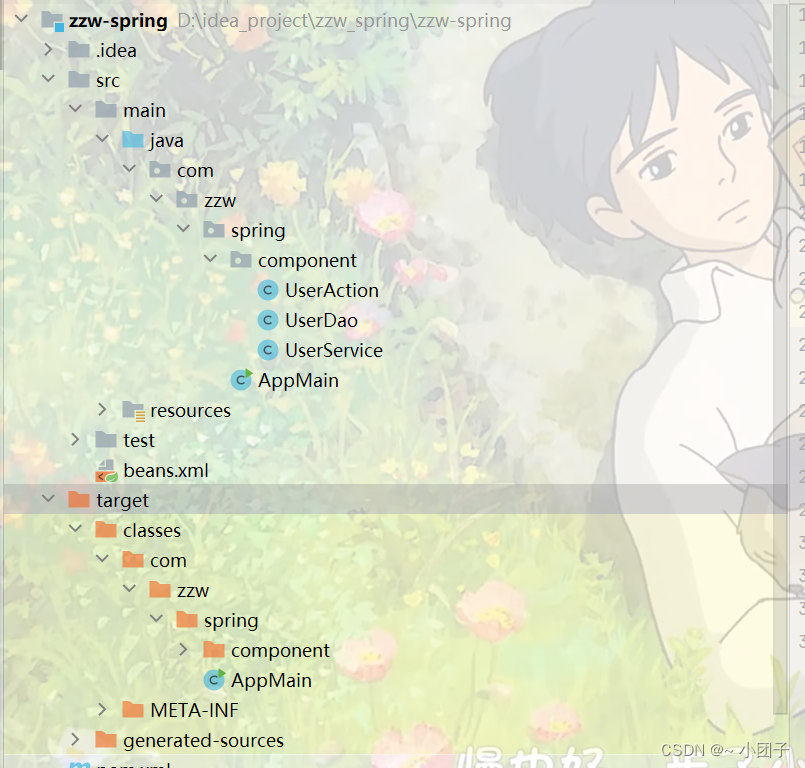
//就是一个Controller
//也可以使用 @Controller
在默认情况下, 我们配置@Component,@Repository,@Controller,@Service 是单例
@Component
public class UserAction { }
//也可以使用 @Repository
@Component
public class UserDao {public void hi() {System.out.println("UserDao hi()...");}
}
//也可以使用 @Service
@Component
public class UserService {//也可以使用 @Resource@Autowiredprivate UserDao userDao;//定义一个属性public void m1() {userDao.hi();}
}
src目录下创建beans.xml
<?xml version="1.0" encoding="UTF-8"?>
<beans xmlns="http://www.springframework.org/schema/beans"xmlns:xsi="http://www.w3.org/2001/XMLSchema-instance"xmlns:context="http://www.springframework.org/schema/context"xsi:schemaLocation="http://www.springframework.org/schema/beans http://www.springframework.org/schema/beans/spring-beans.xsd http://www.springframework.org/schema/context https://www.springframework.org/schema/context/spring-context.xsd"><!--配置自动扫描的包, 同时引入对应的名称空间--><context:component-scan base-package="com.zzw.spring.component"/></beans>
测试1
public class AppMain {public static void main(String[] args) {//测试/看看是否可以得到spring容器中的bean, 同时看看依赖注入是否OKApplicationContext ioc =new ClassPathXmlApplicationContext("beans.xml");UserAction userAction = ioc.getBean("userAction", UserAction.class);UserAction userAction2 = ioc.getBean("userAction", UserAction.class);System.out.println("userAction=" + userAction);System.out.println("userAction2=" + userAction2);UserDao userDao = ioc.getBean("userDao", UserDao.class);System.out.println("userDao=" + userDao);UserService userService = ioc.getBean("userService", UserService.class);System.out.println("userService=" + userService);}
}
报错: Caused by: java.io.FileNotFoundException: class path resource [beans.xml] cannot be opened because it does not exist, 其错误原因是

实际上 beans.xml 应该在 src/main/resources 下创建
<?xml version="1.0" encoding="UTF-8"?>
<beans xmlns="http://www.springframework.org/schema/beans"xmlns:xsi="http://www.w3.org/2001/XMLSchema-instance"xmlns:context="http://www.springframework.org/schema/context"xsi:schemaLocation="http://www.springframework.org/schema/beans http://www.springframework.org/schema/beans/spring-beans.xsd http://www.springframework.org/schema/context https://www.springframework.org/schema/context/spring-context.xsd"><!--配置自动扫描的包, 同时引入对应的名称空间--><!--说明1.如果我们是普通的java项目, beans.xml放在src目录下即可2.如果我们是java maven项目, beans.xml放在src/main/resources--><context:component-scan base-package="com.zzw.spring.component"/></beans>
此时项目结构图如下所示:

运行结果
userAction=com.zzw.spring.component.UserAction@679b62af
userAction2=com.zzw.spring.component.UserAction@679b62af
userDao=com.zzw.spring.component.UserDao@5cdd8682
userService=com.zzw.spring.component.UserService@d6da883
🐋思考一: 原生Spring如何实现依赖注入和(singleton, prototype)
1.Spring底层如何实现: IOC容器创建和初始化
2.Spring底层如何实现: 根据 singleton, prototype来返回bean对象
案例注入默认是单例注入, 标识了注解@Scope(value = "prototype")后代表多例
//在默认情况下, 我们配置@Component,@Repository,@Controller,@Service 是单例
//@Scope(value = "prototype") 表示以多例形式, 返回 UserAction bean
//多例是懒加载
//思考: Spring容器底层如何实现
@Component
@Scope(value = "prototype")
public class UserAction {}
测试2
public class AppMain {public static void main(String[] args) {//测试/看看是否可以得到spring容器中的bean, 同时看看依赖注入是否OKApplicationContext ioc =new ClassPathXmlApplicationContext("beans.xml");UserAction userAction = ioc.getBean("userAction", UserAction.class);UserAction userAction2 = ioc.getBean("userAction", UserAction.class);System.out.println("userAction=" + userAction);System.out.println("userAction2=" + userAction2);UserDao userDao = ioc.getBean("userDao", UserDao.class);System.out.println("userDao=" + userDao);UserService userService = ioc.getBean("userService", UserService.class);System.out.println("userService=" + userService);//测试一下当前的依赖注入userService.m1();}
}
运行结果
userAction=com.zzw.spring.component.UserAction@60bd273d
userAction2=com.zzw.spring.component.UserAction@121314f7
userDao=com.zzw.spring.component.UserDao@130c12b7
userService=com.zzw.spring.component.UserService@5e600dd5
UserDao hi()...
🐋思考二: 原生Spring容器如何实现BeanPostProcessor
//编写一个后置处理器
public class MyBeanProcessor implements BeanPostProcessor {/*** 在Bean的 init初始化方法前调用** @param bean* @param beanName* @return* @throws BeansException*/public Object postProcessBeforeInitialization(Object bean, String beanName) throws BeansException {System.out.println("postProcessBeforeInitialization() 被调用... " + beanName + " bean=" + bean.getClass());return bean;}/*** 在Bean的 init初始化方法后调用** @param bean* @param beanName* @return* @throws BeansException*/public Object postProcessAfterInitialization(Object bean, String beanName) throws BeansException {System.out.println("postProcessAfterInitialization() 被调用... " + beanName + " bean=" + bean.getClass());return bean;}
}
@Component
public class UserService {@Autowiredprivate UserDao userDao;public void m1() {userDao.hi();}//这里我们需要指定init() 是初始化方法@PostConstructpublic void init() {System.out.println("UserService init()...");}
}
<?xml version="1.0" encoding="UTF-8"?>
<beans xmlns="http://www.springframework.org/schema/beans"xmlns:xsi="http://www.w3.org/2001/XMLSchema-instance"xmlns:context="http://www.springframework.org/schema/context"xsi:schemaLocation="http://www.springframework.org/schema/beans http://www.springframework.org/schema/beans/spring-beans.xsd http://www.springframework.org/schema/context https://www.springframework.org/schema/context/spring-context.xsd"><!--配置自动扫描的包--><context:component-scan base-package="com.zzw.spring.component"/><!--配置后置处理器--><bean class="com.zzw.spring.process.MyBeanProcessor" id="myBeanProcessor"/>
</beans>
测试3
public class AppMain {public static void main(String[] args) {ApplicationContext ioc =new ClassPathXmlApplicationContext("beans.xml");UserAction userAction = ioc.getBean("userAction", UserAction.class);UserAction userAction2 = ioc.getBean("userAction", UserAction.class);System.out.println("userAction=" + userAction);System.out.println("userAction2=" + userAction2);UserDao userDao = ioc.getBean("userDao", UserDao.class);System.out.println("userDao=" + userDao);UserService userService = ioc.getBean("userService", UserService.class);System.out.println("userService=" + userService);//测试一下当前的依赖注入//userService.m1();}
}
运行结果
postProcessBeforeInitialization() 被调用... userDao bean=class com.zzw.spring.component.UserDao
postProcessAfterInitialization() 被调用... userDao bean=class com.zzw.spring.component.UserDao
postProcessBeforeInitialization() 被调用... userService bean=class com.zzw.spring.component.UserService
UserService init()...
postProcessAfterInitialization() 被调用... userService bean=class com.zzw.spring.component.UserService
postProcessBeforeInitialization() 被调用... userAction bean=class com.zzw.spring.component.UserAction
postProcessAfterInitialization() 被调用... userAction bean=class com.zzw.spring.component.UserAction
postProcessBeforeInitialization() 被调用... userAction bean=class com.zzw.spring.component.UserAction
postProcessAfterInitialization() 被调用... userAction bean=class com.zzw.spring.component.UserAction
userAction=com.zzw.spring.component.UserAction@1ffaf86
userAction2=com.zzw.spring.component.UserAction@6574a52c
userDao=com.zzw.spring.component.UserDao@6c1a5b54
userService=com.zzw.spring.component.UserService@1c7696c6
拿掉UserAction的@Scope(value = “prototype”)注解, 运行结果如下
postProcessBeforeInitialization() 被调用... userAction bean=class com.zzw.spring.component.UserAction
postProcessAfterInitialization() 被调用... userAction bean=class com.zzw.spring.component.UserAction
postProcessBeforeInitialization() 被调用... userDao bean=class com.zzw.spring.component.UserDao
postProcessAfterInitialization() 被调用... userDao bean=class com.zzw.spring.component.UserDao
postProcessBeforeInitialization() 被调用... userService bean=class com.zzw.spring.component.UserService
UserService init()...
postProcessAfterInitialization() 被调用... userService bean=class com.zzw.spring.component.UserService
userAction=com.zzw.spring.component.UserAction@71a794e5
userAction2=com.zzw.spring.component.UserAction@71a794e5
userDao=com.zzw.spring.component.UserDao@76329302
userService=com.zzw.spring.component.UserService@5e25a92e
知识点: 基于注解的方式配置后置处理器(别忘了扫描包)
//编写一个后置处理器
@Component
public class MyBeanProcessor implements BeanPostProcessor {/*** 在Bean的 init初始化方法前调用** @param bean* @param beanName* @return* @throws BeansException*/public Object postProcessBeforeInitialization(Object bean, String beanName) throws BeansException {System.out.println("postProcessBeforeInitialization() 被调用... " + beanName + " bean=" + bean.getClass());return bean;}/*** 在Bean的 init初始化方法后调用** @param bean* @param beanName* @return* @throws BeansException*/public Object postProcessAfterInitialization(Object bean, String beanName) throws BeansException {System.out.println("postProcessAfterInitialization() 被调用... " + beanName + " bean=" + bean.getClass());return bean;}
}
<?xml version="1.0" encoding="UTF-8"?>
<beans xmlns="http://www.springframework.org/schema/beans"xmlns:xsi="http://www.w3.org/2001/XMLSchema-instance"xmlns:context="http://www.springframework.org/schema/context"xsi:schemaLocation="http://www.springframework.org/schema/beans http://www.springframework.org/schema/beans/spring-beans.xsd http://www.springframework.org/schema/context https://www.springframework.org/schema/context/spring-context.xsd"><context:component-scan base-package="com.zzw.spring.component"/><context:component-scan base-package="com.zzw.spring.process"/>
</beans>
🐋思考三: 原生Spring容器如何实现AOP
//接口
public interface SmartAnimalAble {float getSum(float i, float j);float getSub(float i, float j);
}
@Component
public class SmartDog implements SmartAnimalAble{public float getSum(float i, float j) {float res = i + j;System.out.println("SmartDog getSum() 结果=" + res);return res;}public float getSub(float i, float j) {float res = i - j;System.out.println("SmartDog getSub() 结果=" + res);return res;}
}
//这是一个切面类
@Aspect
@Component
public class SmartAnimalAspect {//给SmartDog配置前置, 返回, 异常, 最终通知//前置通知@Before(value = "execution(public float com.zzw.spring.aop.SmartDog.getSum(float, float))")public void showBeginLog(JoinPoint joinPoint) {//通过连接点对象joinPoint, 可以获取方法签名Signature signature = joinPoint.getSignature();System.out.println("SmartAnimalAspect-切面类showBeginLog()-方法执行前-日志-方法名-" + signature.getName() + "-参数 "+ Arrays.asList(joinPoint.getArgs()));}//返回通知: 即把showSuccessEndLog方法切入到目标对象方法正常执行完毕后的地方@AfterReturning(value = "execution(public float com.zzw.spring.aop.SmartDog.getSum(float, float))", returning = "res")public void showSuccessEndLog(JoinPoint joinPoint, Object res) {Signature signature = joinPoint.getSignature();System.out.println("SmartAnimalAspect-切面类showSuccessEndLog()-方法执行正常结束-日志-方法名-" + signature.getName() + " 返回的结果是=" + res);}//异常通知: 即把showExceptionLog方法切入到目标对象方法执行发生异常后的catch{}@AfterThrowing(value = "execution(public float com.zzw.spring.aop.SmartDog.getSum(float, float))", throwing = "throwable")public void showExceptionLog(JoinPoint joinPoint, Throwable throwable) {Signature signature = joinPoint.getSignature();System.out.println("SmartAnimalAspect-切面类showExceptionLog()-方法执行异常-日志-方法名-" + signature.getName() + " 异常信息=" + throwable);}//最终通知: 即把showFinallyEndLog方法切入到目标方法执行后, 不管是否发生异常都要执行, finally{}@After(value = "execution(public float com.zzw.spring.aop.SmartDog.getSum(float, float))")public void showFinallyEndLog(JoinPoint joinPoint) {Signature signature = joinPoint.getSignature();System.out.println("SmartAnimalAspect-切面类showFinallyEndLog()-方法最终执行完毕-日志-方法名-" + signature.getName());}
}
<?xml version="1.0" encoding="UTF-8"?>
<beans xmlns="http://www.springframework.org/schema/beans"xmlns:xsi="http://www.w3.org/2001/XMLSchema-instance"xmlns:context="http://www.springframework.org/schema/context"xmlns:aop="http://www.springframework.org/schema/aop"xsi:schemaLocation="http://www.springframework.org/schema/beans http://www.springframework.org/schema/beans/spring-beans.xsd http://www.springframework.org/schema/context https://www.springframework.org/schema/context/spring-context.xsd http://www.springframework.org/schema/aop https://www.springframework.org/schema/aop/spring-aop.xsd"><!--配置自动扫描的包, 同时引入对应的名称空间--><context:component-scan base-package="com.zzw.spring.component"/><context:component-scan base-package="com.zzw.spring.aop"/><!--开启基于注解的AOP功能--><aop:aspectj-autoproxy/><!--配置后置处理器--><bean class="com.zzw.spring.process.MyBeanProcessor" id="myBeanProcessor"/>
</beans>
测试4
public class AppMain {public static void main(String[] args) {//测试/看看是否可以得到spring容器中的bean, 同时看看依赖注入是否OKApplicationContext ioc =new ClassPathXmlApplicationContext("beans.xml");UserAction userAction = ioc.getBean("userAction", UserAction.class);UserAction userAction2 = ioc.getBean("userAction", UserAction.class);System.out.println("userAction=" + userAction);System.out.println("userAction2=" + userAction2);UserDao userDao = ioc.getBean("userDao", UserDao.class);System.out.println("userDao=" + userDao);UserService userService = ioc.getBean("userService", UserService.class);System.out.println("userService=" + userService);//测试一下当前的依赖注入userService.m1();//测试一下AOPSmartAnimalAble smartDog = ioc.getBean(SmartAnimalAble.class);System.out.println(smartDog.getSum(1,2));}
}
运行结果
postProcessBeforeInitialization() 被调用... userAction bean=class com.zzw.spring.component.UserAction
postProcessAfterInitialization() 被调用... userAction bean=class com.zzw.spring.component.UserAction
postProcessBeforeInitialization() 被调用... userDao bean=class com.zzw.spring.component.UserDao
postProcessAfterInitialization() 被调用... userDao bean=class com.zzw.spring.component.UserDao
postProcessBeforeInitialization() 被调用... userService bean=class com.zzw.spring.component.UserService
UserService init()...
postProcessAfterInitialization() 被调用... userService bean=class com.zzw.spring.component.UserService
postProcessBeforeInitialization() 被调用... smartAnimalAspect bean=class com.zzw.spring.aop.SmartAnimalAspect
postProcessAfterInitialization() 被调用... smartAnimalAspect bean=class com.zzw.spring.aop.SmartAnimalAspect
postProcessBeforeInitialization() 被调用... smartDog bean=class com.zzw.spring.aop.SmartDog
postProcessAfterInitialization() 被调用... smartDog bean=class com.sun.proxy.$Proxy16
userAction=com.zzw.spring.component.UserAction@26ceffa8
userAction2=com.zzw.spring.component.UserAction@26ceffa8
userDao=com.zzw.spring.component.UserDao@600b90df
userService=com.zzw.spring.component.UserService@7c8c9a05
UserDao hi()...
SmartAnimalAspect-切面类showBeginLog()-方法执行前-日志-方法名-getSum-参数 [1.0, 2.0]
SmartDog getSum() 结果=3.0
SmartAnimalAspect-切面类showSuccessEndLog()-方法执行正常结束-日志-方法名-getSum 返回的结果是=3.0
SmartAnimalAspect-切面类showFinallyEndLog()-方法最终执行完毕-日志-方法名-getSum
3.0
简析Spring AOP 和 BeanPostProcessor关系
1.AOP实现Spring可以通过给一个类, 加入注解 @EnableAspectJAutoProxy 来指定
2.追一下@EnableAspectJAutoProxy的源码
@Target({ElementType.TYPE})
@Retention(RetentionPolicy.RUNTIME)
@Documented
@Import({AspectJAutoProxyRegistrar.class}) 👈
public @interface EnableAspectJAutoProxy {boolean proxyTargetClass() default false;boolean exposeProxy() default false;
} public void registerBeanDefinitions(AnnotationMetadata importingClassMetadata, BeanDefinitionRegistry registry) {AopConfigUtils.registerAspectJAnnotationAutoProxyCreatorIfNecessary(registry); 👈AnnotationAttributes enableAspectJAutoProxy = AnnotationConfigUtils.attributesFor(importingClassMetadata, EnableAspectJAutoProxy.class);if (enableAspectJAutoProxy != null) {if (enableAspectJAutoProxy.getBoolean("proxyTargetClass")) {AopConfigUtils.forceAutoProxyCreatorToUseClassProxying(registry);}if (enableAspectJAutoProxy.getBoolean("exposeProxy")) {AopConfigUtils.forceAutoProxyCreatorToExposeProxy(registry);}}}
@Nullablepublic static BeanDefinition registerAspectJAnnotationAutoProxyCreatorIfNecessary(BeanDefinitionRegistry registry, @Nullable Object source) {return registerOrEscalateApcAsRequired(AnnotationAwareAspectJAutoProxyCreator.class, registry, source); 👈}
3.看一下AnnotationAwareAspectJAutoProxyCreator的类图

4.解读
1)AOP底层是基于BeanPostProcessor机制的.
2)即在Bean创建好后, 根据是否需要AOP处理, 决定返回代理对象, 还是原生Bean
3)在返回代理对象时, 就可以根据要代理的类和方法来返回
4)机制并不难, 本质就是BeanPostProcessor机制 + 动态代理技术
🐋补充说明
| 后置处理器 | SmartDog类型 |
|---|---|
| postProcessBeforeInitialization() | class com.zzw.spring.aop.SmartDog |
| postProcessAfterInitialization() | class com.sun.proxy.$Proxy16 |
为何: SmartDog 在 postProcessBeforeInitialization() 中类型是普通类型, 在postProcessAfterInitialization()中成了代理类型.
其本质原因在: SmartAnimalAspect类是一个切面类, 并且对SmartDog中的方法做了切入, 所以后置处理器处理成了代理对象.
💗Spring整体架构分析

下乘: Spring系列五:手动实现Spring底层机制, 未完待续…


shellcode 学习)



)
)
节点设计与实现)










